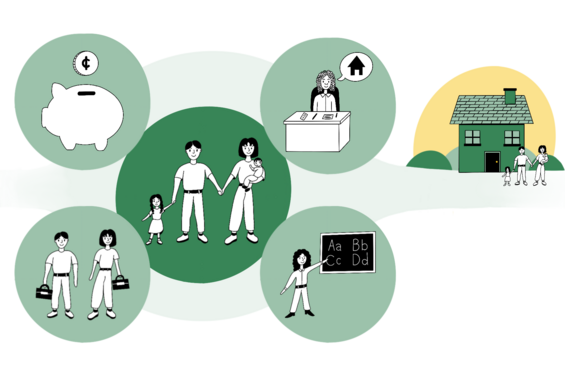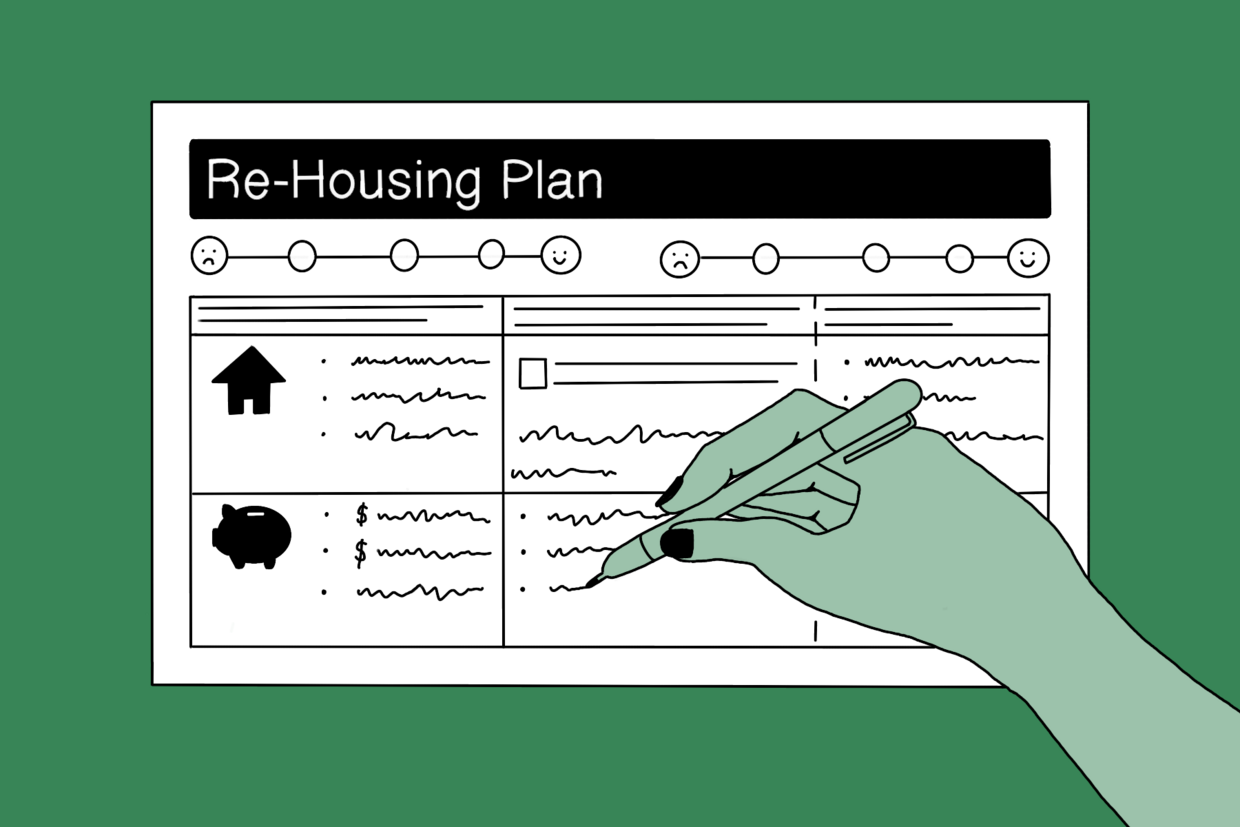What is Re-Housing?

“Re-Housing” is a process to help you find and move into stable housing before you have reached the time limit on your stay in shelter.
For families in the Bridge Shelter Track, there are required monthly re-housing meetings. Families will work with staff to make a plan to get stable housing, learn about HomeBASE and how it can help pay for housing when you leave shelter and build skills that help you stay housed (money management, new job skills, English language skills, etc).
All adults 18 and older living in the Bridge Shelter Track of Emergency Assistance (EA) Family Shelter must take part in Re-Housing activities outlined the Re-Housing Plans that your family will create and commit to completing.
What does the Re-Housing Process look like every month for families in the Bridge Shelter Track?
You will have two different types of meetings:
- Monthly Re-Housing Meetings: All families in the Bridge Shelter Track are required to be a part of a monthly Re-Housing Process as a part of EA Family Shelter. Every 30 days, your case manager and/or a re-housing worker will meet with at least one member of your family for a Re-Housing Meeting. In these meetings staff have two major goals:
- 1) to assess your family’s current strengths, needs and housing search status with a Re-Housing Assessment (RHA) and
- 2) to help you make a monthly plan to search for housing with a Re-Housing Plan (RHP) and to learn how to pay for that housing using the HomeBASE program.
- Bi-Weekly Case Management Meetings: At least every 2 weeks, families in the Bridge Shelter Track will meet with your case manager. These weekly meetings can help you with any barriers that come up with tasks in your Re-Housing Plan. These meetings happen in between your monthly Re-Housing Meetings.
What is part of the Monthly Re-Housing Meetings?
As mentioned above, there are two parts of your monthly Re-Housing Meetings: the 60-Day Re-Housing Assessment and the Monthly Re-Housing Plan.
Re-Housing Meeting Part #1: What is the 60-Day Re-Housing Assessment?
You will fill out and update your 60-day Re-Housing Assessment (RHA) with your shelter provider. This will happen in every other Re-Housing Meeting.
Important: If you do not complete a Re-Housing Assessment at least every 60 days, you can be asked to leave shelter.
The goals of the RHA are to:
- Assess your family’s housing goals
- Connect you with resources for your financial and housing needs (such as job training, money management courses, legal support for immigration, etc.)
- Determine if your family is eligible for an extension past the nine month limit to your shelter stay
What can I expect when completing the 60-Day Re-Housing Assessment?
Your Re-Housing Worker or Case Manager will ask you a series of questions. They will write your answers on a form on their computer.
How long will it take?
The first time you complete the Re-Housing Assessment it may take up to an hour, especially if you are using a translator. After that, updates to your RHA will take a lot less time because many questions will be the same.
Can I get a paper copy?
You may want a copy of all the questions to follow along in your meeting. You can ask the person helping you to print you a blank form. You can also ask for a printed copy of the completed form.
What if I need a translator?
The person helping you will ask if you would like a translator. You can ask for a translator even if you are working with a staff person who speaks your language. For example, you may be having difficulty understanding the staff person’s accent. You can still ask for a translator.
Re-Housing Meeting Part #2: What is the Monthly Re-Housing Plan?
Every month at your Re-Housing Meeting, you will complete a required Re-Housing Plan. You will work with your Case Manager (CM) or Housing Search Worker (HSW). This is a personal, step by step plan for you to find and keep stable housing. Each family’s plan will be different because you have different goals and barriers.
The goals of the Re-Housing Plan are to:
- Create a clear plan to move toward stable housing.
- Support your family in setting achievable housing goals that move your family toward the long-term future you want.
- Provide a monthly space of support and accountability on the actions you plan and commit to.
Key Facts:
- Creating this monthly plan with goals and activities, and then fulfilling on that plan, is required to live in shelter.
- After you create your plan with shelter staff, you will sign the plan.
- The plan must outline at least 30 hours of Re-Housing activities for all adult family members, which will be adapted to how each family member is contributing toward moving out of shelter (direct housing search, attending classes, etc.)
- You will create a new plan each month. It should be based on what progress you made in the month before or any new barriers that come up.
- This is your plan and your meeting. It should make sure that you meet your housing stability goals and can successfully move out of shelter.
View the Re-Housing Plan:
View the Re-Housing Plan:
English | Spanish | Portuguese | Haitian Creole | Cape Verdean Creole
View the Housing Search Log (part of the Re-Housing Plan):
English | Spanish | Portuguese | Haitian Creole | Cape Verdean Creole
View the Savings Sheet (part of the Re-Housing Plan):
English | Spanish | Portuguese | Haitian Creole | Cape Verdean Creole
View the Weekly Task Sheet (part of the Re-Housing Plan):
English | Spanish | Portuguese | Haitian Creole | Cape Verdean Creole
What can I expect when completing the monthly Re-Housing Plan?
- All the actions included in your Re-Housing Plan should forward your family’s housing and stability goals.
- There are four sections:
- Finding My New Home (Housing Search)
- Long Term Success: Saving 30% of Net Income
- Meeting with Your Case Manager
- Other Activities (e.g.: Credit Repair, Classes, Career Center, Childcare Vouchers)
- For each section you will:
- Report back on the actions you promised from the last month.
- Commit to new actions for the coming month.
- Your case manager will provide referrals to help you fulfill your stated goals.
- For example, you might be trying to reduce spending. Your case management team could provide addresses and phone numbers for food banks.
- At the end of the meeting, your case manager will ask you to sign the Re-Housing Plan.

